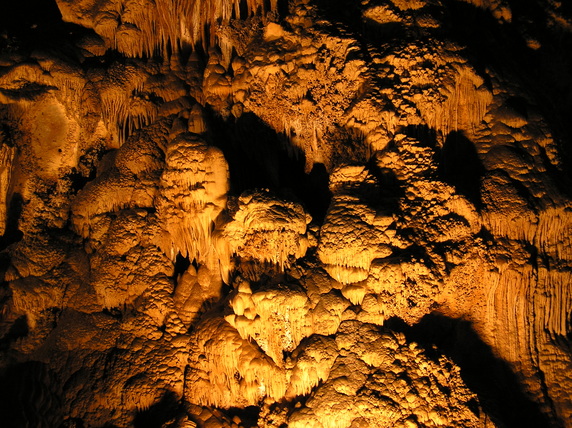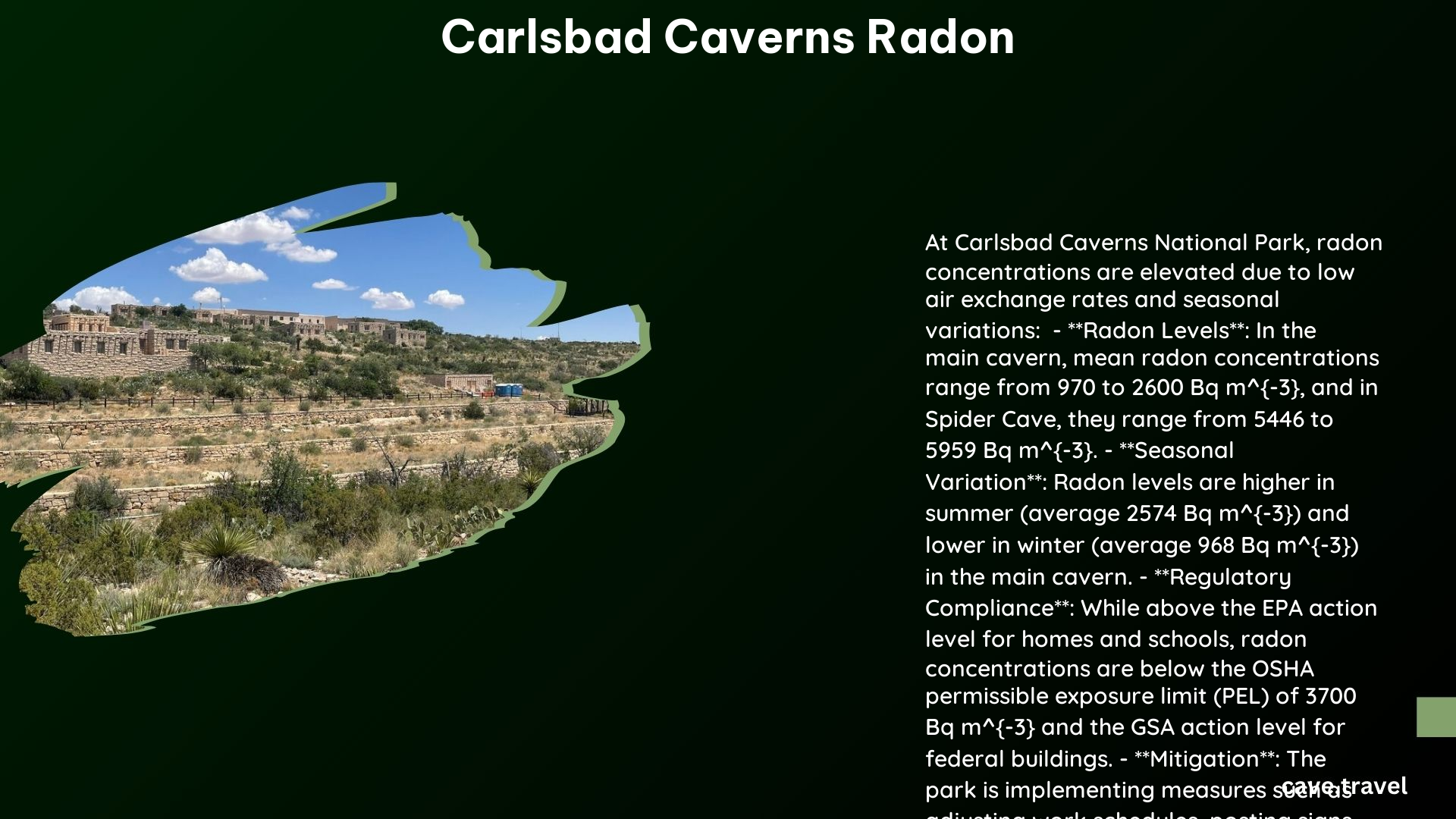Carlsbad Caverns, a renowned natural wonder, harbors elevated radon levels due to its unique geological composition. This radioactive gas, formed by uranium decay, accumulates in the cave system’s enclosed spaces. While the caverns remain safe for visitors, ongoing monitoring and mitigation efforts are crucial. This article explores the current radon concentrations, safety guidelines, and measures implemented to protect both staff and tourists at this iconic National Park.
What Are the Current Radon Concentration Levels at Carlsbad Caverns?

Radon concentrations at Carlsbad Caverns vary significantly depending on location and season. Recent studies have provided detailed insights into these levels:
Main Cavern
- July to December: 66.7 pCi/L (2,470 Bq/m³)
- December to April: 25 pCi/L (925 Bq/m³)
Spider Cave
- Consistent range: 147 to 161 pCi/L (5,440 to 5,960 Bq/m³)
- Minimal seasonal variation
Visitor Center
- July to December: 12.9 pCi/L (477 Bq/m³)
- December to April: 11.8 pCi/L (437 Bq/m³)
Other Buildings
- Maintenance building: 2.65 pCi/L (98.1 Bq/m³)
- Superintendent’s building: 0.60 pCi/L (22.2 Bq/m³)
These measurements reveal a complex pattern of radon distribution throughout the park, with the highest concentrations found in the cave systems and lower levels in above-ground structures.
What Do Recent Radon Testing Results Show?

The National Institute for Occupational Safety and Health (NIOSH) conducted comprehensive testing between 2014 and 2016. Key findings include:
- Elevated radon levels in the main cavern and Spider Cave
- Seasonal variations in the main cavern’s radon concentrations
- Minimal seasonal changes in Spider Cave’s radon levels
- Higher unattached fraction of radon progeny compared to typical workplaces
Despite the elevated levels, all measurements remained below the Occupational Safety and Health Administration’s (OSHA) Permissible Exposure Limit (PEL) of 100 pCi/L (3,700 Bq/m³) for adult workers.
What Are the Established Radon Safety Guidelines?
Several regulatory bodies have set guidelines for radon exposure:
| Organization | Guideline Type | Limit |
|---|---|---|
| OSHA | Permissible Exposure Limit (PEL) | 100 pCi/L (3,700 Bq/m³) |
| GSA | Action Level (non-childcare, non-residential) | 25 pCi/L (925 Bq/m³) |
| EPA | Action Level (homes and schools) | 4 pCi/L (148 Bq/m³) |
These guidelines provide a framework for assessing and managing radon exposure risks in various settings, including Carlsbad Caverns.
How Are Radon Risks Assessed and Managed at Carlsbad Caverns?
The National Park Service has implemented a comprehensive approach to radon risk assessment and management:
- Regular Monitoring: Continuous measurement of radon concentrations in various park areas.
- Employee Training: Educational programs on radon exposure risks and safety protocols.
- Engineering Modifications: Recommendations for structural changes to reduce radon accumulation.
- Time Tracking: Monitoring employee time spent in high-radon areas to limit exposure.
This multi-faceted approach ensures that both staff and visitors are protected while allowing continued access to this natural wonder.
What Measures Are in Place to Mitigate Radon Exposure for Visitors?
While Carlsbad Caverns remains safe for tourists, several measures have been implemented to minimize radon exposure:
- Adoption of a comprehensive action plan by the National Park Service
- Ongoing monitoring of radon levels throughout the park
- Implementation of engineering modifications to improve ventilation
- Ensuring visitor center and main cavern exposures remain below OSHA PELs
These measures demonstrate the park’s commitment to visitor safety while preserving the natural integrity of the caverns.
How Does Radon Form in Carlsbad Caverns?
Radon formation in Carlsbad Caverns is a result of its unique geological composition:
- Uranium-rich limestone: The caverns are formed in limestone containing trace amounts of uranium.
- Radioactive decay: Uranium slowly decays, producing radium as an intermediate product.
- Radon gas release: Radium further decays, releasing radon gas as a byproduct.
- Accumulation: The enclosed cave system traps the radon, leading to higher concentrations.
This natural process explains the elevated radon levels found throughout the cavern system.
What Are the Health Implications of Radon Exposure at Carlsbad Caverns?
While radon exposure at Carlsbad Caverns is a concern, it’s important to understand the context:
- Short-term visitors: Minimal risk due to limited exposure time
- Park employees: Potential for increased risk, mitigated by safety protocols
- Long-term health effects: Primarily associated with prolonged, high-level exposure
The National Park Service’s proactive approach helps minimize these risks for both staff and visitors.
How Does Carlsbad Caverns Compare to Other Cave Systems in Terms of Radon Levels?
Carlsbad Caverns’ radon levels are notable, but not unique among cave systems:
- Mammoth Cave (Kentucky): Similar or higher radon concentrations
- Wind Cave (South Dakota): Comparable radon levels
- Jewel Cave (South Dakota): Also exhibits elevated radon concentrations
This comparison highlights that radon accumulation is a common feature in many cave systems, requiring similar management approaches across various national parks.
By addressing these key questions, we gain a comprehensive understanding of the radon situation at Carlsbad Caverns. The park’s commitment to safety, combined with ongoing research and mitigation efforts, ensures that this natural wonder remains accessible while minimizing potential health risks.
References:
– https://www.cdc.gov/niosh/hhe/reports/pdfs/2014-0158-3345.pdf
– https://stacks.cdc.gov/view/cdc/112443/cdc_112443_DS1.pdf
– https://www.nps.gov/cave/learn/news/carlsbad-caverns-national-park-adopts-report-recommendations-to-mitigate-radon.htm
